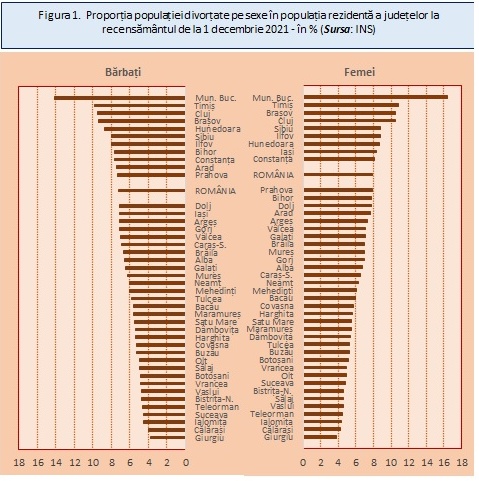
The structure of the population by marital status refers to 100 generations, which make up the permanent population of the country on the date of the census (there are more, but we stop at 100). Marital status registered in censuses is legal. The final census data will also provide us with information on the number of people living in a marriage union according to various characteristics, and we will be able to learn about the scale of the phenomenon of massive expansion of the European population (during the 2011 census, data on women aged 15 and older who are living in marriage were published (there were 372 thousand).
Knowledge of the structure of the entire population of the country by marital status has not only demographic, but also social, economic and other significance due to the numerous consequences it has in the life of society.
The picture presented by the census regarding this demographic structure of the population is the result of a long evolution over time of some demographic, economic, social and cultural phenomena, attitudes towards the institution of legally formalized marriage and personal unions, towards dissolution of marriage through divorce, the influence of religious doctrines on marriage, divorce (termination of pregnancy). Some factors are primarily sociological, psychological, economic, in the case of marriage, divorce, migration and, to some extent, in the case of delayed marriage and celibacy, while mortality is biological (as well as economic, social, cultural and medical). only as the level and structure of mortality by cause of death). Large and long fluctuations in the birth rate, such as the recovery after 1989, affect the size of the young population, mostly unmarried. The two world wars led to an increase in the number of widowed women, with long-term consequences due to excessively high male mortality. Migration in youth and adulthood, although selective with respect to marital status, the case of emigration in the 1990s and early 2000-2010, when youth and unmarried adults had a constant proportion, may reduce the proportion of the unmarried population in the permanent population, as emigration after 2010, consisted mostly of only one of the spouses who advocated for divorce. Such fingerprints have data from the 2021 census. Therefore, the comparative appearance is good to distinguish between men and women. We will not prioritize the unmarried and married populations, the states with the majority of the population modeled in terms of size and proportion of the factors mentioned, and we will focus mainly on DIVORCE and WIDOWS, where there is considerable variation by age and sex. These variations represent a structural echo of the other two civil states.
Divorced population
The divorced population has a share of 7 percent for men and 8 percent for women, with such relatively small values, the difference can be considered moderate. Figure 1 shows the proportions by county and for men and women, with the capital dominating the hierarchy with values of 14 and 16 percent for men and women. The counties of Timișoara, Cluj, Brasov, Sibiu, Ilfov, Constanta, Hunedoara are placed with values of 11-8 percent for both sexes. Several other counties have only 8 percent women. The lowest rates, 4 percent for both sexes, are found in the counties of Giurgiu, Kalaras, Jalomica, and are added to the women of Teleorman. Nearby are other districts, especially from the North-East region and 3 regions from the South. It is difficult to find uniform criteria for placing districts in the ranking, but for some of them, explanations can be found. The counties with the highest values are economically more developed counties, with important university centers, more urbanized (and large cities), a higher proportion of young people, and marriages and divorces.

There is a correlation between the share of the young population (20-34 years) and the share of the divorced population, a higher share of the first indicator leads to a similar share of divorces, especially noticeable in the capital and in the districts of Timiş, Cluj, Sibiu, Ilfov. Feedback can be found in the counties of Teleorman, Jalomitsa, Giurgiu, Buzeu, Kalarasi. It is possible to add the structure of the population by the level of education, a component of the overall degree of development, to the territorial profile, and the correlation is investigated in the article for its special significance. The moderately higher values of the share of divorced women in the upper part of the figure may indicate a less intensive process of remarriage after divorce, probably among divorced women with children. Small shares of the divorced population in the northeastern region and the three regions in the south are caused by the factors already mentioned, and the emigration of the young population to the Bucharest-Ilfov region and the three regions of Transylvania can be added. External migration had the same consequences. In several cases in Bistrytsia-Neseud and Suceava counties, a small share can be explained by belonging to certain religious denominations (more than 8 percent of the permanent population in two counties declared the Pentecostal religion (the Christian cult of the Pentecostals – the Apostolic Church of God). These or other mentioned correlations can be found in more developed and less developed countries Read the full article and comment contributors.ro
Source: Hot News
James Springer is a renowned author and opinion writer, known for his bold and thought-provoking articles on a wide range of topics. He currently works as a writer at 247 news reel, where he uses his unique voice and sharp wit to offer fresh perspectives on current events. His articles are widely read and shared and has earned him a reputation as a talented and insightful writer.